

brand Communication Strategy
In order to put together a marketing plan to support your KFC Delivery Service, there are a couple of things you need to have already completed. They include:
- Store Profiling Template
- Topline Template
These would already have been completed during your marketing planning process for the forthcoming 12 months.
The information contained in these documents will give you insights into:
- Marketing dynamics within your restaurant
- Opportunities and gaps that can be addressed via marketing
- Consumers already visiting your restaurant
- A detailed outline of what is in the area surrounding your restaurant
- Your franchise group objective and a SWOT analysis of your restaurant (from a marketing perspective)
These will give you a good idea of where your best opportunities are and where to focus your marketing energy.
Is delivery something consumers want?
Yes! Consumers, today, live a time-starved existence where they have an increasing need for convenience, in all aspects of their lives. This need for convenience is driving a number of decision making processes. The KFC Delivery Service offers consumers the taste that they love, now through an even more convenient way
The first objective that needs to be achieved is to tell consumers that you have a delivery service. Therefore, the first marketing objective is:
brand Communication Strategy
You can achieve this by driving top-of-mind awareness initiatives to make consumers aware of your service, and remind them again and again. Some examples of various marketing elements from South Africa to assist you are given below:
Menu:
A menu has been created which can be distributed to homes, businesses, universities etc in the surrounding area via Knock & Drops or at intersections. It is vital to get this information into consumers’ hands as often as possible to make the delivery decision as easy as possible. You can also attach a magnetic strip on the back of the menus so that consumers can keep them handy on their fridges at home / work. You can also give out menus with every purchase that happens in-store.

brand Communication Strategy

LETTERS:
Letters have been created to introduce KFC Delivery to the surrounding homes and businesses. The wording has been chosen to highlight the service, in the KFC brand tone, whilst communicating the benefit of convenience. Pictures of menu items are included to keep food the hero of all the marketing activities that we do. You can choose the relevant food product(s) to put onto the letter, depending on which target market you are appealing to.
brand Communication Strategy

ENVELOPE
An envelope has been designed for the letters to be put into. The reason for this design is to create interest for consumers to open it.
brand Communication Strategy
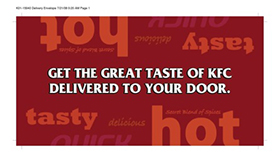
DELIVERY MAGNET:
This magnet is to help keep your KFC Delivery service top-of-mind. It is highly recommended to include the telephone number so consumers know who to call. You want to make the ordering process as convenient as possible. Therefore, it is important to ensure consumers always have the tools they need to order with you. Hence, the importance of the menu and the magnet.
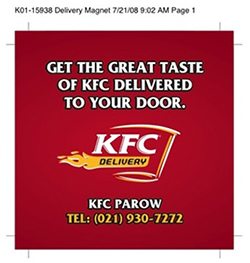
brand Communication Strategy
EXTERNAL BANNER
A banner/billboard is helpful to inform consumers of your delivery service, and remind them to use it. It is best to place these banners outside of your restaurant in a highly visible location to passing commuters.

PULL UP BANNER
Should you wish to advertise your KFC Delivery service inside your restaurant, you can use a pull up banner in front of the ordering counter. Once we have established capability and processes within the store, its time now to build sales by reaching out to larger customer base.
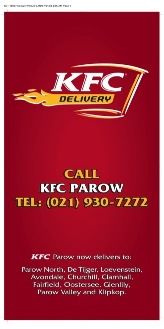
LOCAL STORE Marketing
What is local store marketing:
Consumer promotion or awareness activities undertaken by the respective stores to build sales is known as Local Store Marketing or LSM
Strengths
- Gives the RGM ownership of their store sales
- Gives the RGM flexibility to address specific needs for his store
Issues
- RGM has more than enough – can’t t devote much time to marketing
- Printing materials for 1 or 2 stores can get expensive and time consuming
Solution
- Provide a system for the RGM to draw from
- Create adapted materials and produce them economically
- Assist the RGM in making the best choice of the LSM
Core LSM team
LSM needs cross functional collaboration between marketing and Operations team but is owned and driven by Ops team. There are two core team members in LSM team.
LOCAL STORE Marketing
Marketing / LSM Manager
- Define marketing objectives, national calendars and budgets
- Define and implement marketing tools
- Provide a system for LSM Programs & materials
- Coach area coaches & RGMs on how to make LSM decisions
- Give feedback on ways to improve effectiveness of communication
Area Coach & RGM
- Be responsible for sales and customer satisfaction in their stores
- Understand their trade area
- Look for opportunities to increase sales using g LSM materials
- Use their local knowledge to organize and optimize LSM programs
- Support LSM training of the team
- Maintain operations on or above target
Planning an LSM program
There are six key steps to be followed while planning an LSM program.
Focus on Your Business
- Identify areas of opportunity by analyzing sales, day-part & menu mix
LOCAL STORE Marketing
- Identify strengths & weaknesses as well as threats and/or opportunities
Forcus on your trade area
- Identify and understand your customers
- Identify resources for new customers
- Identify and understand your competitors
To begin understanding your trade area, start by exploring it. Since trade area tend to change frequently, due to new business development, competitive growth and area improvements. Every six months, you should explore trade area for any changes.
While you are exploring out, get to know you customers and competitors
Determine your objectives
- Identify your problem
- Make sure it is measurable, obtainable, specific, and time based
Select & plan your LSM
- Keep in mind the environment, time of year, individual market dynamics and the competition
- Determine if your program is cost effective and what the breakdown will be
LOCAL STORE Marketing
Program
- Prepare your crew with launch in-store
Measure your results
- Track your program results to determine its success

Example:
PH UK analyzed data to identify area of focus:
LOCAL STORE Marketing
Insight: 42% of customers ONLY visited once in the past 12 months
Inference: We must get our existing customers to come back and order more often
Action:
Incentivizing 2nd/3rd Orders To Build Purchase Habit
- New Customer : Within 12 days of 1st order
- Frequency Builder : 30-60 days from expected order date
- Retention : Expected to order +/- 30 days from the pull date
- Lapsed : 30-90 days past expected order date
- Win Back : Lost customers >90 days
Other questions that will help you deep dive:
Frequency
- Majority of our customers have ordered only once in the past 6 months ….do we know the reasons?
- What can we do to create a habit of ordering from KFC?
- How do we define success? What systems support do we need?
LOCAL STORE MARKETING
Top 100 customers:
- How do we reward our Top 100 customers for being loyal?
- How do we get more such customers?
- Food : Pre-launch communication and opportunity to be amongst the first few customers to order new product?
- Service:
- Contact numbers of RGMs for queries, resolution?
- Priority call centre access? Birthday wishes and a KFC Dine-in offer?
- Price Value:
- KFC calendar and a booklet of offers based on past purchase behavior?
Lapsed customers:
- How do we win back our lapsed customers? Do we know the reasons for the dramatic drop?
- Do we win them back through an attractive offer - next 3 orders?
- Is there a service complaint that needs to be resolved?
- Is there a competitor that needs to be countered?
- Does our menu need to become more relevant?
LOCAL STORE MARKETING
Types of LSM Programs:
Types of LSM programs:
- Focus on big, chain-retail partners iwth similar target groups as KFC
- Negotiate with the partner headquarters; work out a barter exchange e.g. clothing retail chains, language schools, fitness clubs, etc.
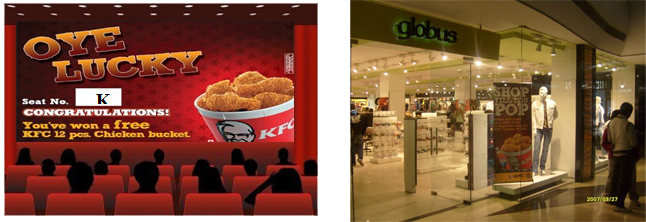
Example: Video Store Program
Objective : Attract new customers
Grow takeout / delivery sales
LOCAL STORE MARKETING
Target:
- Current KFC users and video store customers
Strategy
- Cross promote in each store
Execution
- customer purchase from KFC at a certain value get a coupon for free video rental; customers renting from video store get a coupon for free KFC or certain $ off.
- Program supported by POS in both stores
Hints:
Ensure stafff of both stores are well briefed and there is proper display of POS materials.
Incentivize the video store by offering free pizza for every 15 coupons redeemed. Choose a video store that is close to the KFC unit to encourage instant redemption.
Direct Couponing
Example:Come back coupons
Objective: Increase purchase frequency and/or average spend
Target: Existing Customers
LOCAL STORE MARKETING
Strategy
- Encourage customer to come back more quickly with short expiry dates
- Or get customers to trade by offering meal deals or great prices for add-ons on their next visit
Execution
- Determine your requirement e.g frequency, offer, featured product
- Be specific on expiry dates (reasonably short) and valid stores
Hints
- Select a coupon format that can easily fit in customers wallet
- Validate with company stamp and date to minimize abuse
- Keep a bunch of comeback coupons next to cashier to ensure team members give them out when customers pay
Store Opening/Reopening
Directional signage
Specific targets groups
Frequency Card
Special occasions
LOCAL STORE MARKETING
In order to build sales the stores can make use of Delivery LSM toolkit. This is an exclusive LSM Guide focusing on Delivery, alike the existing toolkit which is focused on the Dine In and Take Away. The store can identify the specific LSM initiate to be deployed basis the store specific need and sales building opportunities.
The Delivery LSM toolkit is aimed to resolve for the following:-
- Increase awareness for KFC Delivery in the trade area
- Drive frequency among new & current delivery customers
- Driving ticket average among core delivery customers
Depending upon the store format (High Street, Mall & IT park), we can identify ready to use LSM initiatives for various customer profile:
- Corporate
- Residential
For sharper focus of plans, this toolkit segregates activities for Residential & Corporate customers.
This docket can be used as a ready reckoner for:-
- Selecting appropriate LSM campaigns for delivery, relevant to the store’s Trade Area
- Focus programs for targeted customer groups
- Visuals for collateral that can be used
Click here to download the KFC India LSM Toolkit LSM Toolkit
Pizza Hut has great program known as “Own the zone” that helps to equip YOU, our captains on the frontline, with the weapons and strategy to win the battle for ‘OUR TRADE ZONES’.
LOCAL STORE MARKETING
You can download this best practice for your reference from the link below: Own the Zone Leaders
Download the leaflet scheduler Leaflet Scheduler
Download pod optimizer Pod Optimizer
ART OF LEAFLETING
Click below to:
View the video on how to use the Pod Optimizer
Download the leaflet scheduler Leaflet Scheduler
WINNING BACK LAPSED CUSTOMERS
Lapsers are those customers on the home delivery database who have not ordered in last 3 months
In each store there are many customers who have lapsed i.e. they have not ordered in the last 3 months. Whilst some of it is natural attrition i.e. due to factors like shift in residence, change in store delivery zone etc. there are many who would have started ordering from competition instead of KFC.
Through this program we seek to:
- Who are these lapsers for your store
- Find out the reasons for lapsing
- Address these reasons
- Win back the lapsers!
The approach to winning back needs to be highly personalized because each lapser could have his own unique reason for not ordering from KFC anymore.
But talking to thousands of customers in each store is very difficult and might not be cost effective. Therefore we need to prioritize, and start by addressing lapsers with most potential i.e. the top 100 lapsed customers in your store.
Who are lapsers for your store:
STEP 1. RGM sends the database to Delivery Manager.
STEP 2. Delivery Manager analyses the data and identifies the top lapsed customers (lapsers). These are typically about 40% of the total lapsers and contribute approximately 80% of the total lapsed business. These lapsers will then be divided into the following two tiers:
Priority 1: The top 100 lapsers
Priority 2: The top 40% lapsers excluding the top 100
WINNING BACK LAPSED CUSTOMERS
Here is an actual example to demonstrate how this prioritization will be done:
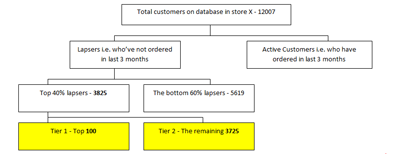
STEP 3. Priority 1 Customers i.e. Top 100 lapsers’ names, addresses and telephone numbers will be sent to RGMs in a structured format (see the enclosed 1st top 100 lapser list for your store) along with this coaching manual.
Through this program, we will target the lapsers shown in the yellow boxes.
The program for Priority 2 lapsers will involve mailing to be done centrally from Delivery Manager. This will be based on the feedback collected by RGMs
Establish reason for lapsing
After RGM receives the top 100 lapsed customers’ list, he does the following:
Identify those who lapsed for natural reasons
- Customers who may still be ordering but maybe from a different telephone number. Indicate such customers on the list and mention the other telephone number they are ordering from in the space provided on Format 1.
- Customer who have moved residence.
- Customers who are now not covered due to changes in the delivery area.
WINNING BACK LAPSED CUSTOMERS
Also identify the non-natural lapsers
These are all the customers for whom none of the above reasons is applicable. A telephone call is made to all these customers as per script detailed on the following pages
Tele Script
Step1
KFC: Hello, this is (Employee Name) from KFC (Store Name). May I speak with Mr./Ms. (Customer Name) please?
Customer: Yes, I am (Customer Name). -----------------------------------Go to 2
Or
Customer: No, (Customer Name) no longer stays here. --------------Go to 3
Or
Customer: (Customer Name) is not here at the moment. -------------Go to 4
Step 2.
KFC: Good (Time of day) Mr/s (Customer Name). Our records indicate that you have not ordered from KFC for quite some time. May I take two minutes of your time?
Customer: Yes. ----------------------------------------------------------------Go to 5
Or
Customer: No. -----------------------------------------------------------------Go to 6
WINNING BACK LAPSED CUSTOMERS
Step 3.
KFC: Thank you sir/madam, have a good day. End the call.
Step 4.
KFC: May I speak to someone else who orders pizzas from here?
Customer: Yes. --------------------------------------------------------------Go to 2
Or
Customer: No, only (customer name) orders pizza from here. -Go to 7
Step 5.
KFC: Mr/s (Customer Name), could you share with us the reasons for your not ordering from KFC?
Customer: Gives the reason.
If complaint
KFC: We regret the inconvenience caused to you. I will share your feedback with my manager. What would be the appropriate time for him/her to meet you?
Customer: Mentions a time. ---------------------------------Follow up as described in section C
Or
Customer: I would not like to meet him. ----------------Follow up as described in section D1
WINNING BACK LAPSED CUSTOMERS
If no complaint
KFC: Thank you very much for your time and feedback Mr/s (Customer Name) hope you will give us another opportunity to serve you again.
Step 6.
KFC: Mr/s (Customer name) what would be a convenient time to call you back?
Customer: Call me at (time)
KFC: Thank you very much Sir/Madam I will call you at (time). End the call.
Call later at specified time.
or
Customer: Please do not call again --------------------------------------------------------Go to 8
Step 7.
KFC: What time would he/she be available?
Customer: He/she is available at (time)
KFC: Thank you very much. Have a nice day/evening
Call later at the specified time
WINNING BACK LAPSED CUSTOMERS
Step 8.
KFC: Thank you for your time. Have a good day/evening
Indicate in the report that customer did not want to speak
Tel No |
Lapsed customer's name |
Spoke on Tel |
Reason(s) given by customer for not ordering recently with KFC |
CODING (based on Reason given: Natural = N/ Unnatural = UN) |
Visited home (Y/N) |
|
|---|---|---|---|---|---|---|
668608 |
Mr. X |
Y |
Ordering from new Tel No. The new number is 669208 |
N |
N |
|
6535321 |
6535321 |
Ms Z |
Y |
Had coupons from ____ Brand which I wanted to finish using (details of offer) |
UN |
Y |
Fill in the contact details only after making contact with the right person i.e. a person who orders KFC from the household, and after he has given you some feedback. It is treated as a contact if you get feedback. Please fill in one row per customer.
Column 1: Fill in the telephone number of the customers contacted
Column 2: Fill in the name of person from whom the feedback is taken.
Column 3: Tick when the tele contact has been made
WINNING BACK LAPSED CUSTOMERS
Column 4: Write the reason for which the customer has stopped ordering. In case the reason is that the customer is ordering from a different number, write the new number in details column
Else code as `UN’ (unnatural).
Column 6: Tick when the person has been visited.
Win back the lapsers
RGM visit to the customer
This would be required only if the customer has lapsed for non natural reasons i.e. wherever the customer has mentioned taste, price or experience etc. for reasons of dissatisfaction
- RGM goes through the reasons that customer has given and prepares a suitable response in his mind.
- Thereafter he visits the customer on the scheduled time and addresses the reasons that the customer has given for not ordering.
- On his visit, he carries a KFC order with him to be given with compliments of KFC to the customer. The KFC order should be the same as what the POS system reflects as the customer having ordered the last time.




